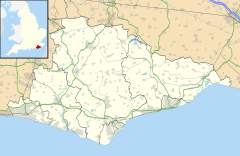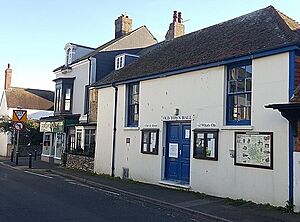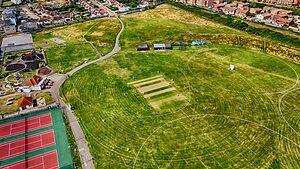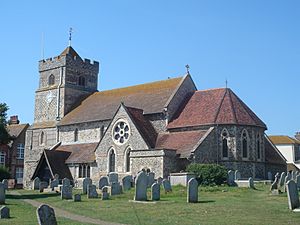Seaford, East Sussex facts for kids
Quick facts for kids Seaford |
|
|---|---|
 Seaford viewed from off-shore with the Head in the background |
|
Coat of Arms of Seaford |
|
| Area | 6.327 km2 (2.443 sq mi) |
| Population | 22,862 (Parish-2011) |
| • Density | 3,613/km2 |
| OS grid reference | TV482990 |
| • London | 67 miles (108 km) north |
| Civil parish |
|
| District |
|
| Shire county | |
| Region | |
| Country | England |
| Sovereign state | United Kingdom |
| Post town | SEAFORD |
| Postcode district | BN25 |
| Dialling code | 01323 |
| Police | Sussex |
| Fire | East Sussex |
| Ambulance | South East Coast |
| EU Parliament | South East England |
| UK Parliament |
|
| Website | Seaford Town Council |
Seaford is a town located in East Sussex, England. It lies to the east of Newhaven and west of Eastbourne.
In the Middle Ages, Seaford was a very important port for Southern England. However, its importance faded because sand and mud built up in its harbour. French pirates also attacked the town many times. Seaford was part of a group of coastal towns called the Cinque Ports. These towns worked together for defence. Between 1350 and 1550, French raiders burned Seaford down several times. There are old stories that say people from Seaford would sometimes trick ships into crashing. They would place fake harbour lights on the cliffs. This way, they could collect goods from the wrecked ships.
Seaford became important again in the 1800s. This was when the railway arrived, connecting the town to Lewes and London. It grew into a small seaside resort. More recently, it has become a place where people live and travel to work. Many residents commute to larger nearby towns like Eastbourne and Brighton, or even to London.
The traditional way to say Seaford in Sussex is "sea-ford" (/ˈsiːfɔːrd/). But outside Sussex, and more and more within it, people often say "SEE-furd" (/ˈsiːfərd/).
Contents
Exploring Seaford's Location
The town of Seaford is on the coast, close to Seaford Head. It is located about halfway between the mouths of the River Ouse and the Cuckmere rivers. The Ouse valley used to be a wide area of water affected by tides. Its mouth was almost blocked by a shingle bar (a ridge of pebbles). But now, the muddy areas and salt marshes have been protected by dykes. This has turned them into grassy, freshwater marshes.
To the north of Seaford are the chalk hills of the South Downs. Along the coast to the east, you can see the famous Seven Sisters chalk cliffs and Beachy Head. This part of the coast is special because of its unique geology and wildlife. It is called the Seaford to Beachy Head Site of Special Scientific Interest.
How the Coastline Changed
The River Ouse used to flow along the shore behind the shingle bar. It entered the sea near Seaford. However, a big storm in the 1500s broke through the bar at its western end. This created a new river mouth near a village called Meeching. That village was later renamed Newhaven. A part of the old river channel still remains as a brackish lagoon (water that is a mix of fresh and salt).
Seaford once had excellent beaches. Sand was constantly moved along the coast from west to east by ocean currents. But in the early 1900s, a large breakwater (a wall built into the sea) was constructed at Newhaven Harbour. The harbour entrance was also regularly dug out. These changes stopped new sand from reaching Seaford beach. By the 1980s, the beach at Seaford had almost disappeared. The shoreline became steep and narrow, mostly made of small rocks. This was good for watersports because the water was clear and deep. But it wasn't great for general beach visitors.
So, in 1987, a huge project was done to bring sand back to the beach. About 1 million tonnes of material were taken from sandbanks out at sea. This material was then placed on the shore. During a severe storm that October, a lot of the new sand was washed away. Since then, the beach has been topped up several times. Now, Seaford has a wide beach of sand and shingle.
The town's official website says that "For many, the main attraction in Seaford is the beach." It brings many visitors, especially in summer. Sea temperatures can reach up to 20°C (68°F) then. East of Seaford, below chalk cliffs, is a beach called Hope Gap. This location was featured in the film Hope Gap.
Seaford's Past: A Look at History
In the early 1600s, William Levett was the bailiff (a local official) of Seaford. His family had lived in Sussex for a long time. The Old Town Hall on South Street was where the town council met. This council used to have the power to choose two members of parliament. This changed after the Reform Act 1832 was put into place.
Sports and Fun Activities
Seaford has many sports and leisure activities for everyone.
Cricket and Rugby
The Seaford Cricket Club has played at the Salts Recreation Ground since 1946. Cricket has been played in Seaford since the 1700s. In 2010, their clubhouse was made bigger. The Seaford Rugby Football Club also plays at the Salts Recreation Ground. This ground is special because it is actually below sea-level!
Football
Seaford Town is the local football club. They play at the Crouch Playing Field. They are part of the Sussex County Football League.
Golf and Bowling
The town has two golf courses. Seaford Golf Club is a course on the hills at Firle Road. Seaford Head Golf Course offers amazing views of the coastline and the South Downs. Seaford also has at least two bowling clubs. These include Seaford Bowling Club and The Crouch Bowling Club.
Leisure Centre and Swimming
The Downs Leisure Centre runs 'The Wave' in Seaford. The Wave is a leisure centre that offers many sports and activities. These include badminton, indoor bowls, and fitness classes. Swimming is available at Seaford Head Swimming Pool, which is also run by Wave Leisure.
Sailing and Walking
Near the western end of Seaford Bay is the Newhaven and Seaford Sailing Club. It was started in 1952. The club has two locations: one for racing off Seaford Beach and another for sailing at Piddinghoe Lake. The area around Seaford is great for walking. You can explore places like the Cuckmere Valley and the South Downs Way.
News and Media
Local news and TV shows for Seaford come from BBC South East and ITV Meridian. You can get TV signals from a transmitter in Newhaven. Local radio stations include BBC Radio Sussex and Seahaven FM. The town's local newspaper is The Argus.
Getting Around Seaford
Seaford has good transport links.
Bus Services
Two local bus services, the 119 and 120, run every half hour. They are provided by Cuckmere Buses and Compass Bus. Compass Bus also runs bus 126 from Seaford to Eastbourne. Brighton & Hove operates two frequent bus services, the 12 and 12A. These buses run along the A259 south coast road through Seaford. They take passengers to Brighton or Eastbourne, which have many more bus connections.
Train Services
Seaford station is the end of the Seaford Branch Line. Trains run to Brighton through Lewes. Trains usually run twice an hour. These services are operated by Southern.
Famous People from Seaford
Many interesting people have lived in or had connections to Seaford:
- Robert Back, a maritime painter, lived in Seaford for most of his life.
- Sir Anthony Blunt, who worked for the Queen, went to school in Seaford. He was later found to be a spy.
- Actor Tony Caunter, known from EastEnders, once lived here.
- Clementine Churchill, wife of Prime Minister Winston Churchill, lived in Seaford.
- Actor Nigel Davenport attended St Peter's School in Seaford.
- Composer and pianist Norman Fraser retired to Seaford.
- Paul Garred, drummer for the band The Kooks, grew up in Seaford.
- Comedian Dickie Henderson went to school in Seaford.
- Chess player David Howell, the UK's youngest grandmaster, grew up here.
- Actress Dame Penelope Keith went to school in Seaford.
- Former motorcycling stunt rider Eddie Kidd now lives in Seaford.
- Saint Lewine, an early British saint, had her relics moved to Seaford in 1058 AD.
- Actor Oscar Lloyd, from Emmerdale, was born in Seaford.
- Val McCalla, founder of The Voice newspaper, lived in Seaford.
- NBA basketball player Michael Olowokandi went to school in Seaford for a short time.
- Singer-songwriter Don Partridge lived in Seaford.
- Twin actresses Connie Powney and Cassie Powney, from Hollyoaks, grew up in Seaford.
- Photographer Grace Robertson lived in Seaford.
- Actress Margaret Rutherford went to school in Seaford.
- The astronaut Piers Sellers attended a school in Seaford.
- Artist Eric Slater lived and died in Seaford.
- Writer Bruce Stewart lived in Seaford.
- Drummer Pete Thomas, known for working with Elvis Costello, grew up in Seaford.
- Drummer and model Tennessee Thomas lived in Seaford before moving to California.
- Cricketer Colin Wells lives in Seaford.
Learning in Seaford: Schools and Education
Between the late 1800s and the 1950s, Seaford was known as a "school town." Many preparatory schools (schools for younger children) and other private schools were the main employers. In the 1960s, a road sign warned, "7 schools in next mile." On Sunday mornings, you would see groups of schoolchildren walking to church from their schools.
Most of these private schools, like Ladycross School and St Peter's School, closed down. Their land was used for new houses in the late 1900s. The last girls' school, Micklefield, closed in 1994.
Seaford has several primary schools, including Chyngton, Cradle Hill, Annecy, and Seaford County Primary. However, the town has only one state-run secondary school, Seaford Head School. This school closed its sixth form (for older students) in 2009 but reopened it in 2014. Seaford was also home to a private school called Newlands Preparatory and Manor. This school had a special unit for students with learning difficulties. However, it closed in July 2014, and its site is now being turned into houses.
The town also has a special needs boarding school called Bowden House. It is run by Tower Hamlets Council.
Places to Worship
Parts of the Church of England parish church of St Leonard are from the 11th century. The church has Norman and Early English Gothic features. The tower was built in the 14th century. The church is a Grade I listed building, meaning it is a very important historical building. St Luke's Church, built in 1959, serves the Chyngton and Sutton areas of the town.
The Roman Catholic Church of St Thomas More was built in 1935. It replaced an older chapel.
A Congregational chapel was built in 1877. It is now a United Reformed church called Cross Way Clinton Centre. It has links with the town's Methodist church, now called Cross Way Church. A Baptist chapel in the town centre was taken down in 1973. A new circular church was built in its place. Seaford also has a Jehovah's Witnesses Kingdom Hall, a Spiritualist church, and an Evangelical church.
The Quaker community meets every Sunday in The Little Theatre. They also have a Peace Garden nearby.
Seaford's Military Connections

The Romans are known to have had a camp in Seaford a very long time ago. From 1794, coastal defence barracks were set up at East Blatchington. Between 1806 and 1808, a Martello Tower was built at the eastern end of Seaford Bay. This tower was part of a chain of defensive towers along the coast.
During the First and Second World Wars, there were large military camps in Seaford. In the First World War, these camps housed soldiers. In 1919, two thousand Canadian soldiers rioted after one of them was hurt.
Seaford has connections to seven people who received the Victoria Cross. This is the highest award for bravery in the British military:
- William George Walker lived and died in Seaford.
- Cuthbert Bromley lived in Seaford.
- William Frederick McFadzean trained in Seaford.
- Geoffrey Charles Tasker Keyes went to King's Mead School in Seaford.
- David Auldjo Jamieson attended Ladycross School in Seaford.
- Claud Raymond lived in Seaford.
- H. Jones attended St Peter's School in Seaford.
Twin Towns
Seaford is twinned with two towns in Germany:
- Bönningstedt, Germany
- Crivitz, Germany
Freedom of the Town
Some people and military groups have been given the special honour of "Freedom of the Town" of Seaford.
Individuals
- Field Marshal Charles Lennox, 3rd Duke of Richmond: 1789.
- William Pitt the Younger: 1789.
- Neil Moffett: 1980.
- Laurie Holland: 30 September 2012.
- Donald Mabey: 30 September 2012.
- Keith Blackburn: February 2019.
Military Units
- 210 (Sussex) Field Squadron, RE (TA): 1959.
|
See also
 In Spanish: Seaford para niños
In Spanish: Seaford para niños






